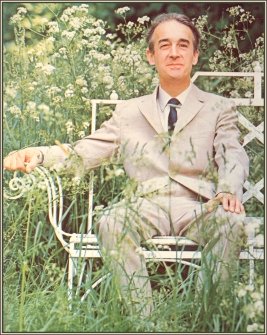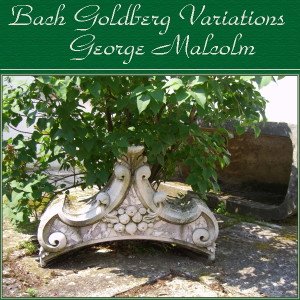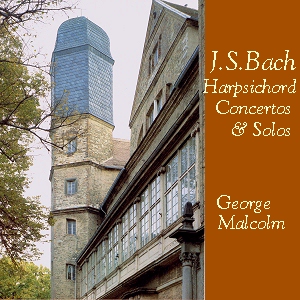GEORGE MALCOLM CBE, Harpsichordist, Pianist, Organist, Conductor, Choirmaster, Composer: born London 28 February 1917; Master of the Cathedral Music, Westminster Cathedral 1947-59; CBE 1965; Papal Knight of the Order of St Gregory 1970; ISM Distinguished Musician Award 1996/7, died London 10 October 1997.
George Malcolm will be identified in many people’s minds as a Harpsichordist, Choir Master or Conductor. In fact he first studied the piano. He was taught for 18 months by a gifted Nun in the kindergarten class at the Notre Dame Convent in Clapham, and, deciding he had a special talent, she took him along to play to Sir Hugh Allen at the Royal College of Music. He was accepted, and at the age of seven studied piano with Kathleen McWhitty. There was no Junior department at the College in those days, and for several years he was the only child there. While attending a London day school, he continued at the College and then, having completed his time at Oxford University, he returned to take up his studies with Herbert Fryer. He was on the threshold of his career as a professional pianist when the onset of war drastically changed the direction of his life. He was appointed an RAF Bandleader, which involved organising and conducting concerts all over the country. After the war he had hoped to resume his intended career as a pianist, but fate was to take him in a different direction.
“I left the R.A.F. in 1946 when I was demobilised, and I wanted to spend my gratuity on something: I decided that a harpsichord would be an amusing sort of toy to have. I did not know anything about the harpsichord in those days. My training had been that of a purely conventional concert pianist, and as a student I had never even moved among the kind of people who were interested in Baroque music or old instruments. I scarcely knew the difference between a clavichord and a harpsichord; but I thought it would be fun to possess an old keyboard instrument. I had the great good fortune to find a very good instrument, a Shudi-Broadwood of 1775, at an auction. There was not very much competition for them in those days and I got it very cheap. I had it done up and put it in my studio — literally as a toy — something to amuse myself with between bouts of piano practice, with no intention of ever using it professionally. In 1946 it was not anything like so usual to be in possession of a Harpsichord as it is now, and when people found that I had got this very good one, I started to get asked to take it to concerts and play it, and then the whole thing very quickly escalated and before I knew where I was, I was getting quite a lot of harpsichord engagements and very few piano ones, and it just went on from there.” [George Malcolm in an interview in 1973]
The Harpsichord was rare then, and very soon George and his Harpsichord were in great demand for concerts. His favourite instrument was to be built by Thomas Goff, and was known for its marvellous dynamic qualities, which George used to exciting and dramatic effect, with his brilliant harmonies and ornamentations. He later had a Robert Goble Harpsichord in his London home-studio as he found it was a versatile modern harpsichord with many modern pedal facilities and was reliable and easy to maintain.
While his concert career was being established, he was appointed director of Music at Westminster Cathedral in 1947. He had a deep affinity with Catholic Church Music and enjoyed a successful period of time as Choirmaster of this Catholic London Cathedral (not to be confused with the nearby Church of England Westminster Abbey). He disliked the “hooting” sound so prevalent in choirboys at that time, and was to achieve great success in producing the bright “Continental” sound that so impressed Benjamin Britten when he wrote his “Missa Brevis” especially for the Westminster Cathedral Choir. Although he was himself a good organiser, and a tireless worker, Malcolm always spoke his mind to the point of being prickly. He was a brilliant Organist. As a Choirmaster he was strict, even testy at times, but there was a mutual affection with the Westminster Cathedral Choir.
He left the Cathedral in 1959 after 12 years as Director of the Choir to enable him to accept the ever increasing demands on him for concert performances on the Harpsichord. He became Artistic Director and Conductor of the London Philomusica from 1962 to 1966 following Granville Jones who had taken charge of the orchestra when Thurston Dart left. Then he became Associate Conductor of the B.B.C. Scottish Symphony Orchestra as well as continuing to give numerous Recitals of the large 18th century Harpsichord repertoire in Britain and Germany, as well as all over the rest of Western and Eastern Europe, including Russia.
George Malcolm: “I know it is a very vexed question what kind of harpsichord one plays. Most of my colleagues won’t have anything to do with what they consider to be a modernized version of the harpsichord. They don’t like the heavier sound, and they don’t like the pedal gadgets. They refuse to use the gadgets simply because Bach did not have gadgets. And although even people like Couperin acknowledged the expressive deficiencies of the classical harpsichord — they still won’t. . . Most of my foreign engagements happen to be in West Germany where there is a tremendous market for harpsichord music on the full-bodied modern instruments and it’s no accident that I’m never asked to play in Holland where they are very ‘authentic instrument’-minded, and they don’t approve of me at all!”
George Malcolm loved giving Harpsichord Recitals but was not so at ease in a recording studio. As he put it: “It’s an artificial atmosphere, and I need people to play to. Playing is a form of communication, and I like an audience to be there. I don’t so much mind a live broadcast as I know there’s an audience there even though I can’t see them. But playing in a gramophone studio with the electronic ear of a microphone standing there waiting for me to make a mistake, just makes me more nervous than anything else. I’m terribly nervous in the studio — far more than on the concert platform. Playing in an Ensemble is quite another matter — there is the communication between the artists.
“I have recorded the Bach and Handel Violin Sonatas with Yehudi Menuhin who is absolutely at ease in the gramophone studio, and that communicates and makes for a lovely calm atmosphere. In fact, with the Handel Sonatas we had great fun because in the slow movements we were both improvising. Yehudi was making decorations to the melody and I was doing all sorts of naughty things in the continuo realization. And then there would come an incident when the producer would say that we would have to do the second half of that movement again, and ‘will you please both try and play the same as what you played last time’ — of course neither of us could remember what we played!”
Malcolm composed too: some pleasing church numbers and a fine set of Variations on a Theme of Mozart for Four Harpsichords composed for himself and Thurston Dart, Valda Aveling and Geoffrey Parsons to play at one of Thomas Goff’s 4-Harpsichord Bach jamborees at the Royal Festival Hall in the late 1950s and early 1960s.
The day before he was due to record on the harpsichord Alec Templeton’s Bach Goes To Town, the producer rang up and asked what they could put on the other side of the record. “Oh, I’ll bring something,” he said and sat up all night writing a brilliant fugue in the style of Bach with a subject based on the sailor’s hornpipe, a three-minute number that should have been called “Bach Goes to Sea” but became Bach Before the Mast. A brilliant piece, and typical of a great all-round musician.
from Baroque Music Library
Baroque Music Page www.BaroqueMusic.org for a complete listing of all our Baroque Music sites.
 there’s more |


